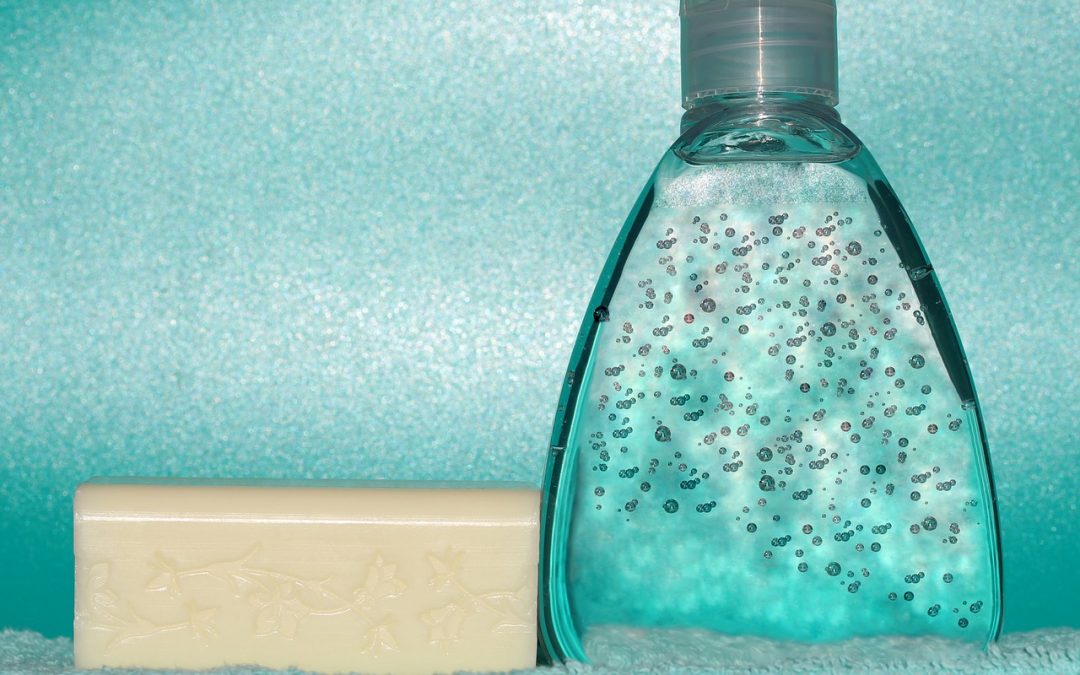I) Introduction
As the COVID-19 pandemic of 2020 continues to increase the demand for hand sanitizer, it is useful to understand how different hand sanitizers work and their properties. In this paper, we will explore alcohol and non-alcohol-based hand sanitizers as well as hand washing within the context of SARS-CoV-2, COVID-19 or coronavirus, as it is more commonly known.
II) Background
Most people are aware that ‘germs’ are what cause illnesses, or even more explicitly that these ‘germs’ consist of bacteria and viruses. Bacteria are eukaryotic cells, an enveloped cell containing cytoplasm and organelles. 1 They can cause illness by causing damage to the host cell, the overall body of the host, or through the delivery of toxins within the body. Viruses are structures which contain RNA or DNA in a protein structure that is sometimes surrounded by a lipid bilayer. They cause illness by entering a host cell and replicating, which causes altered function, structure, or death of the cell.
COVID-19 is a lipophilic enveloped virus. It is part of the coronavirus family; a family of viruses which cause upper respiratory problems such as the common cold, severe acute respiratory syndrome from SARS-CoV, and Middle East respiratory syndrome. 2 These viruses can be referred to collectively as coronaviruses.
Hand sanitizers sold in Canada must follow the antiseptic skin cleansers (personal domestic use) monograph from Health Canada. 3 The monograph permits hand sanitizers to contain ethyl alcohol (ethanol) at 60-80% and 2-propanol (isopropanol) at 60-75% as active ingredients. Hand sanitizers that use alcohols as their active ingredients are classed as Natural Health Products. The monograph also allows other active ingredients; these hand sanitizers are classed as non-prescription drugs. These actives include benzalkonium chloride at 0.1-0.15%, benzethonium chloride at 0.05-0.5%, chlorhexidine digluconate at 2-4%, chloroxylenol at 0.5-3%, and triclosan at 0.1-1%. In the United States, hand sanitizers are considered OTC antiseptics. 4 The US FDA declares that a product can be marketed as a hand sanitizer if it contains ethyl alcohol, isopropyl alcohol, or benzalkonium chloride as the active ingredient.
III) Effectiveness of Alcohol-Based Hand Sanitizers
Currently, many alcohol-based hand sanitizers use ethanol (ethyl alcohol) or isopropanol (isopropyl alcohol) as their active ingredient.5 These alcohol- based hand sanitizers have strong bactericidal properties when the active ingredient is within a 60-90% concentration within the product.6 The bacteriocidic properties come from the alcohols’ ability to denature bacterial proteins, resulting in their death. Alcohol-based hand sanitizers are also viricidal at alcohol concentrations between 60-80%. These alcohol-based hand sanitizers demonstrate strong viricidal and bactericidal properties even with a short period of contact. In fact, ethanol at concentrations between 62-71% have been shown to reduce coronavirus infectivity within one minute of exposure time by 2.0–4.0 log10. 7
In a study conducted by H.F. Rabenau et al. in the Efficacy of Various Disinfectants Against SARS Coronavirus, several different disinfectants were tested against SARS-Cov, including sanitizers based on ethanol. It was found that the sanitization products inactivated the SARS-CoV below the limit of detection. 5 This is an indication that ethanol-based hand sanitizers should also have an impact on the virus behind COVID-19 as the two demonstrate similar stability patterns on surfaces.8 Finally, it was found in a comparison study that although alcohol-based hand sanitizers that use ethanol or isopropanol are both effective, ethanol has been experimentally determined to be more effective within a shorter period of time.9
IV) Effectiveness of Non-Alcohol-Based Hand Sanitizers
An alternative to alcohol-based hand sanitizers is non-alcohol-based hand sanitizers, which commonly consist of active ingredients benzalkonium chloride or benzethonium chloride. Hand sanitizers and other sanitization products based on these ingredients are known more for their impacts on bacteria than on viruses.
The bactericidal actions of benzethonium and benzalkonium chloride comes from their ability to inactivate energy producing enzymes, denature essential proteins, and ultimately cause damage to the bacterial cell membrane.6 Due to the multiple levels of bacterial destruction that benzethonium and benzalkonium possess, they are considered better at managing bacteria than alcohol-based products, in certain cases. For example, benzethonium chloride is more effective than ethyl alcohol below 70% in destroying serratia marcenscens, a bacteria. 10 In fact, one test showed that benzethonium chloride destroyed the bacteria at 1.60 log, while alcohol cleansers such as ethyl alcohols below 70% only destroyed the bacteria below 1.55 log. This shows that non-alcohol-based hand sanitizers demonstrate strong bacterial destruction against some bacteria. With this being said, it is important to use these sanitization products only when necessary as it has been found that bacteria have begun adapting to overcome these methods of destruction. 11
In addition to benzethonium or benzalkonium chloride-based products’ efficacy against certain bacteria, they are also effective against some viruses. 12 Specifically, benzethonium and benzalkonium chloride-based products have been shown to kill lipophilic and enveloped viruses. The mechanisms through which the chloride ingredients kill viruses requires the virus membrane to attract the benzalkonium molecules, which causes the initial damage to the virus membrane, resulting in apoptosis of the virus cell. As SARS-CoV-2 is an enveloped virus, these products would be expected to be effective in preventing Covid-19.13
It has been found that benzalkonium and benzethonium chloride products work better with longer contact. As such, these products can be found in surface cleaners more than hand sanitizers. It should also be noted that in some countries, hand sanitizers based on benzethonium and benzalkonium chloride cannot be advertised as a prevention against Covid-19.13 Although it has been hypothesized that these products have an effect against COVID-19, there are currently no studies that have clearly identified this. Therefore, regulatory bodies like US FDA and Health Canada encourage the use of an alcohol-based hand sanitizer over a non-alcohol-based hand sanitizer whenever possible, as non-alcohol-based hand sanitizers are ‘less reliable for tackling Covid-19′ (CDC, 2020). 14
V) Absorption of Ethanol through the Skin
The question that is raised from time to time is whether or not ethyl alcohol can be absorbed through the skin and have health impacts on vulnerable groups, such as women who are pregnant or lactating. Evidence does not support this. Studies have shown that alcohol from hand sanitizers does not absorb in any significant quantities through the skin.15 Even with damage to the epidermis, dermis, or the frequent use of hand sanitizers, the slight alcohol absorption is still limited and does not cause a clinical concern.
Other than the oral route, ethanol can be inhaled when boiled. Gaseous ethanol reaches pulmonary circulation from the alveoli in the lung. It can then pass directly via the pulmonary vein into the left ventricle and from there to the brain (without first-pass metabolism). However, this is not a concern as the levels inhaled from hand sanitizer at room temperature do not cause a significant blood-alcohol level to be of a clinical concern. Therefore, the choice between alcohol and non-alcohol-based hand sanitizers should not be decided through the consideration of safety, as both are safe even for vulnerable groups. 16
VI) Hand Washing
It is important to understand that despite the effectiveness of hand sanitizers, the best method for removing traces of COVID-19 is thorough hand washing.17 This is due to the similarities between lipid bilayer membrane of the virus and the structure of soap and synthetic detergents. Soap attracts the virus membrane which causes unrepairable damage to the virus membrane killing it or making it nonvirulent. The use of water further aids in the destruction as it dissolves the virus, destroying it further. Additionally, the mixture of water and soap running off the hands carries the virus and its debris with it, further decreasing the chance of infection. 18 This is unlike hand sanitizer as although the virus is no longer a significant source of infection, the ‘dead’ viruses remain on your hands. Therefore, it is always best to choose hand washing rather than using hand sanitizer whenever possible.
VII) Conclusions
In the end, it is expected that both alcohol and non-alcohol-based hand sanitizers are likely to be effective in the defense against COVID-19. Alcohol-based hand sanitizers have been found to be more effective against this family of viruses than non-alcohol-based hand sanitizers, especially those containing ethanol as the active ingredient. Non-alcohol-based hand sanitizers with active ingredients such as benzalkonium and benzethonium are expected to still be effective against COVID-19, as it is an enveloped virus. Both types of hand sanitizers are safe for use as active ingredients are used within safe limits and have shown to not cause any clinical concerns. However, hand sanitizer should only be used secondary to hand washing as hand washing has been shown to be the most effective method against COVID-19.
For more information, please contact Focal Point Research Inc at mail@focalpointresearch.net. We are leading North American Regulatory and New Product Consultants for Medical Devices, Natural Health Products, OTC Drugs, Cosmetics, and other consumer products regulated by Health Canada and the U.S. FDA.
References
- Kumar, V., Abbas, A. K., Aster, J. C., & Robbins, S. L. (2018). Robbins Basic Pathology. Amsterdam: Elsevier.
- Coronaviruses. Retrieved July 30, 2020, from https://www.niaid.nih.gov/diseases-conditions/coronaviruses
- Government of Canada, H. (2007, May 08). Antiseptic Skin Cleansers (Personal Domestic Use). Retrieved July 30, 2020, from http://webprod.hc-sc.gc.ca/nhpid-bdipsn/atReq.do?atid=antiseptic_antiseptique
- Commissioner, O. FDA issues final rule on safety and effectiveness of consumer hand sanitizers. Retrieved July 30, 2020, from https://www.fda.gov/news-events/press-announcements/fda-issues-final-rule-safety-and-effectiveness-consumer-hand-sanitizers
- H.F. Rabenau., G. Kampf., J. Cinati., H.W. Doerr. Efficacy of various disinfectants against SARS coronavirus. 61 (2005), 107-111.
- Chemical Disinfectants. (2016, September 18). Retrieved July 30, 2020, from https://www.cdc.gov/infectioncontrol/guidelines/disinfection/disinfection-methods/chemical.html
- G. Kampf., D. Todt., S.Pfaender., E. Steinmann. Persistence of coronaviruses on inanimate surfaces and their inactivation with biocidal agents. 104 (2020), 246-251.
- Seladi-Schulman, J. (2020, April 03). Coronavirus vs. SARS: How Do They Differ? Retrieved July 30, 2020, from https://www.healthline.com/health/coronavirus-vs-sars
- Yashpal S. Malik BVSc, PhD., Sunil Maherchandani BVSc, PhD., Sagar M. Goyal BVSc, PhD. Comparative efficacy of ethanol and isopropanol against feline calicivirus, a norovirus surrogate. 34 (2006), 31-35.
- Sickbert-Bennett. E., Weber. D., Gergen-Teague. M., Sobsey. M., Samsa. G., Rutala. W. Comparative efficacy of hand hygeine agents in the reduction of bacteria and viruses. 33 (2005), 67-77.
- Jackson, M. Safety and Effectivemess of Health Care Antiseptics; Topical Antimicrobial Drug Products for Over-the-Counter Human Use. (2018).
- Golin, A., Choi, D., & Ghahary, A. (2020, June 18). Hand sanitizers: A review of ingredients, mechanisms of action, modes of delivery, and efficacy against coronaviruses. Retrieved July 30, 2020, from https://www.ncbi.nlm.nih.gov/pmc/articles/PMC7301780/
- Center for Drug Evaluation and Research. QAs Hand sanitizer and COVID-19. Retrieved July 30, 2020, from https://www.fda.gov/drugs/information-drug-class/qa-consumers-hand-sanitizers-and-covid-19
- Murugesu, J. Hand sanitiser. Retrieved July 30, 2020, from https://www.newscientist.com/term/hand-sanitiser/
- Brewer, Colin., Streel, Emmanuel. Is Alcohol in Hand Sanitizers Absorbed Through the Skin or Lungs? Implications for Disulfiram Treatment. 55 (2020), 354-356.
- Evans, Virginia A. MD; Orris, Peter. The Use of Alcohol-Based Hand Sanitizers by Pregnant Health Care Workers. Journal of Occupational and Environmental Medicine. 54 (2012).
- Rigby, S. (2020, April 20). Coronavirus: Is hand-washing really the best thing we can do to stop the spread of COVID-19? Retrieved July 30, 2020, from https://www.sciencefocus.com/news/coronavirus-can-hand-washing-really-stop-the-spread-of-covid-19/
- Welsh, E. (Co-host)., Allmann Updyke, E. (Co-host)., Rasmussen, A. (Guest). (March 23, 2020). ‘COVID-19 Chapter 1: Virology’ This Podcast Will Kill You [Audio podcast]. Retrieved from https://thispodcastwillkillyou.com/2020/03/23/covid-19-chapter-1-virology/


Recent Comments